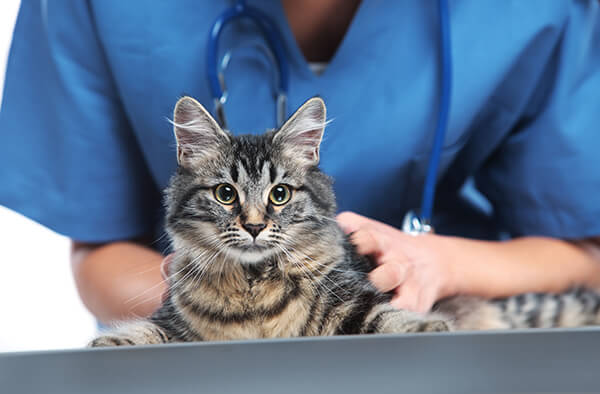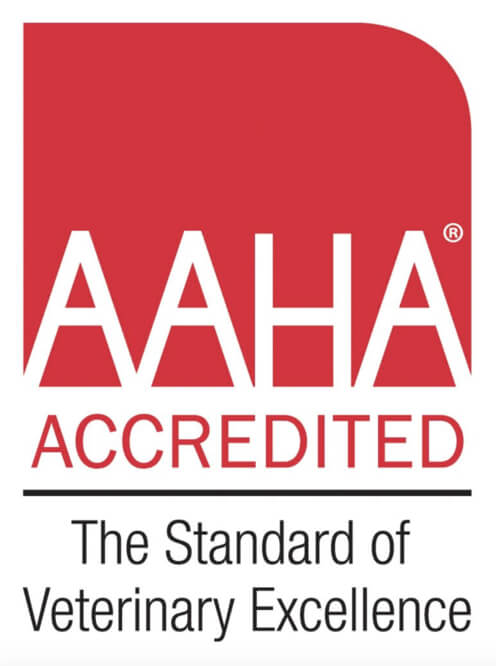
Both dogs and cats can experience thyroid related disorders, however they are typically affected in different ways. Dogs are commonly much more prone to develop hypothyroidism, or low thyroid hormone (thyroxine) levels, and generally at younger ages. Conversely, cats almost always develop hyperthyroidism (high thyroxine levels). Hyperthyroidism also seems to occur in cats at middle age or older.
Thyroxine is an important hormone that plays an essential role in regulating an animal’s metabolism, growth and development, as well as other bodily functions.
In this article we will look at the causes, symptoms and treatments of hypothyroidism in dogs, and hyperthyroidism in cats.
Causes of Canine Hypothyroidism
A dog’s thyroid gland is a small butterfly-shaped organ located at the base of the dog’s throat, having a lobe on each side of the trachea. Thyroid disorders can be attributed to different causes. One is an immune system disorder called autoimmune thyroiditis, which essentially means the body is attacking the tissues of the thyroid gland.
The dog’s thyroid will first try to respond to the attack by producing more thyroxine. Eventually, the gland can become depleted and the capacity for thyroxine production is reduced more and more eventually leading to a state of hypothyroidism.
A dog’s thyroid gland can also become inflamed or shrunken with age. This can also cause a reduction in Thyroxine, that eventually becomes too little to properly regulate the bodily functions that it’s responsible for. Other potential causes of hypothyroidism include certain medications, especially corticosteroids that can have an adverse effect on thyroid functions. Nutritional deficiencies or inefficiencies in bio-chemical processing can also lead to hypothyroidism.
Hypothyroidism in dogs can occur in a variety of breeds, however it is more common in medium to large sized dogs.
Symptoms of Canine Hypothyroidism
Symptoms can vary between individual dogs due to the fact that a thyroid disorder can affect many different bodily functions. One of the most common symptoms is a general display of lethargy, lack of energy and being exercise adverse. There are others that you should be on the look out for:
Hypothyroid symptoms in dogs
-
Weight gain without increase in appetite or calorie intake
-
Skin issues: Discoloration, dry, or thickening of the skin
-
Low tolerance for the cold
-
Excess shedding or scaling
-
Changes in coat quality: dull, dry or brittle
-
Signs of depression or listlessness
-
loss or thinning of the fur
- Noticeable changes in behavior
-
Slowed heart rate
- Skin and ear infections
How is hypothyroidism diagnosed?
Blood tests can confirm a suspected diagnosis of hypothyroidism. Blood testing for hypothyroidism is often performed as a panel of several tests. The results of some of these tests can be influenced by the presence of other non-thyroid diseases, so test results must be considered in light of the whole picture.
The TT4 (total T4) is often the first test to be performed. If the TT4 results return a number in the upper 50% of the reference range this would not be considered hypothyroidism, however it could be and indicator that hypothyroidism could develop down the road. Some dogs also just have a naturally lower TT4 level than others. Typically, if the test results show a low T4 result then you will need to discuss with your veterinarian whether additional blood tests should be performed. There is also a possibility that if the levels are borderline, your vet may recommend monitoring the condition, perhaps trying a nutritional approach and re-test later. They may also suggest starting a medication treatment at that point. A lot of the decision will depend on the individual dog, their overall heath profile, age etc.
How to treat hypothyroidism?
Treating hypothyroidism requires giving an oral thyroid replacement hormone for the rest of the dog’s life. The most commonly recommended synthetic is called levothyroxine (brand names Thyro-Tabs® Canine, Synthroid®). Once the hair coat begins to improve, some dogs can be maintained on once-daily medication. It usually takes 4 to 6 weeks before regrowth of the fur is apparent.
The initial treatment begins with a standard dosage that is based on the dog’s weight. After that, your vet will take another blood sample and adjust accordingly to make sure that the thyroid levels are normal. Over time, your dog’s tolerance of the thyroid replacement hormone can change, so therefore it is usually necessary to retest hormone levels every 6 months. It is also important to monitor your dog’s condition and behavior. If you notice that your dog displays signs of hypothyroidism or hyperthyroidism (weight loss, increased thirst and hunger, increased urination and stool) contact your vet immediately.
If your dog displays any of the above symptoms and you suspect possible hypothyroidism, make an appointment to see your veterinarian. Often, a thyroid disorder happens over time, with hormone levels declining more gradually so it is also a good idea to include thyroid testing in your dog’s annual checkup.

Causes of Feline Hyperthyroidism
Feline hyperthyroidism is the most commonly diagnosed endocrine disorder in domestic cats, especially in middle-age and older cats. In almost all cases, Feline hyperthyroidism is caused by a benign (non-cancerous) tumor or adenoma on the thyroid gland that causes overproduction of the hormone thyroxine.
Thyroxine is an important hormone that plays an essential role in regulating an animal’s metabolism, growth and development, as well as other bodily functions.
The thyroid gland is butterfly-shaped and located at the base of the throat, with one lobe on each side of the cat’s trachea. Overactivity in thyroxine production can cause an abnormal metabolic rate that can negatively affect a cats organs. In addition, to high blood pressure issues, it is often linked to kidney disease. Below are some typical symptoms to be aware of.
Symptoms Of Hyperthyroidism In Cats:
-
Significant weight loss (often accompanied by a voracious appetite)
-
Overeating. Though a loss of appetite is also possible
-
More water intake and increased urination
- Increased heart rate
-
Hair loss
-
Changes in behavior: Hyperactive, irritable, nervousness, sometimes aggression
- Deteriorated coat, changes in grooming habits
-
Vomiting
- Muscle loss. Can also affect heart.
-
Gets out of breath unusually quickly
- Enlarged growth on thyroid noticeable
How is hyperthyroidism diagnosed?
Diagnosis of hyperthyroidism is based on a combination of clinical signs and bloodwork. Weight loss, muscle wasting, heart disease and a thyroid nodule are all indicators to a veterinarian that a cat may have hyperthyroidism. Definitive diagnosis is based on bloodwork, specifically an elevated Thyroxine level. In most cases feline hyperthyroidism can be diagnosed with a single blood test that measures the total thyroxine (T4) concentration.
How To Treat Feline Hyperthyroidism?
Once your cat has been diagnosed with having hyperthyroidism, your veterinarian will consider the factors involved in the case. This would include how elevated the (T4) level is, the cat’s overall heath profile, medical history, and age. There are various options for treating hyperthyroidism, and your vet will discuss them with you and determine the best course of action for treatment.
Medication
Feline hyperthyroidism can be treated with an oral medication that contains methimazole. This medication can be given life-long or to stabilize the cat before other treatment options, such as radioactive iodine therapy or surgery. Felimazole Coated Tablets (methimazole), is the FDA-approved drug to treat hyperthyroidism in cats. The drug is typically given by mouth every 12 hours. Your veterinarian will adjust the dose, as necessary, based on the results of your cat’s blood tests and response to treatment.
Surgery
Surgery is another common treatment for feline hyperthyroidism. It involves the removal of the thyroid gland (thyroidectomy). Your veterinarian will review the case and discuss the options with you. There are two approaches to surgically removing the gland. Sometimes only one of the lobes is affected, so only that lobe need be removed, however data suggests that the other lobe will become affected in 1-2 years, so often the approach is to remove both lobes. Surgery also introduces the concept of anesthesia which may not be viable for an older cat or one with underlying conditions.
Radioactive iodine therapy for hyperthyroidism
Radioactive iodine therapy (I-131) is widely considered the safest and most effective treatment. It has few side-effects and is generally a 1-time treatment in 95% of cats diagnosed with hyperthyroidism. The thyroid stores iodine, and small amounts of radioactivity can stop the overactive gland from producing too much thyroid hormone.
The amounts of radioactivity are too small to affect the rest of your cat’s body, and it is eventually passed out of the body via urine. No general anesthetic is needed, and medication is not required long-term.
Diet control for hyperthyroidism
Some studies have shown that it is possible to treat feline hyperthyroidism with an iodine-restricted diet. Without iodine, the thyroid gland is unable to make any hormones. The affected cat would need to eat a prescription diet with strictly controlled iodine levels. This diet is very strict however, and in order to be effective, the cat must not consume any other food or liquid apart from water.This would be a very challenging diet to maintain if the cat was in a multi-cat environment, or spends time outdoors. It would be nearly impossible to ensure that the cat is not eating any unregulated food and even the smallest amount will allow hormone production to happen. Your veterinarian can provide more information and work with you to decide if this avenue or any of the other treatments would be appropriate for your cat.
Complications of Hyperthyroidism in Cats
The longer hyperthyroidism is left untreated, the greater the risk of significant underlying illnesses such as high blood pressure, kidney disease and heart related issues. Often hyperthyroidism can mask an underlying Kidney disorder and once T4 levels are normalized, it becomes apparent that the Kidney levels are out of balance. Your vet will likely test your cat’s kidney levels after the thyroid treatment to make sure that Kidney function is normal. If you suspect that your cat may be suffering from hyperthyroidism, make an appointment with your veterinarian as soon as possible.

